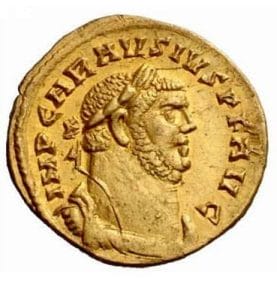Last Updated on December 25, 2021 by Vladimir Vulic
Life: AD ? – 293

- Name: Mausaeus Carausius
- Born in Menapia, date unknown.
- Became emperor in AD 286/7.
- Died AD 293.
Mausaeus Carausius was born to a humble family in Menapia, a region of seafarers in what is today the southern part of the Nertherlands.
After playing a vital part in emperor Maximian’s campaign in AD 286 against the uprising of the bagaudae in Gaul, Carausius was granted command of the North Sea Fleet, based at Gesoriacum (Boulogne).
His new role was to rid the sea of Frankish pirates who were harassing at the shores of Gaul along the Channel. Using his fleet, Carausius succeeded in mastering the pirate menace with a string of naval engagements.
But it wasn’t long before allegations emerged of the plunder, which had been captured off the pirates, being misused. Carausius apparently kep control of it and used it as pay for those pirates which he recruited into the fleet.
This appears to not only substantially enlarged his fleet, but also provided him with good relations to the Franks. If this should have been good news, then emperor Maximian saw in this only the possibility of a rebellion by his powerful fleet commander. If Carausius was really intending to stage a revolt is not known, but Maximian sent orders for his execution.
Carausius, however, heard of these orders and chose to act. In late AD 286 or early 287, he proclaimed himself emperor and moved his fleet to Britain.
Britain (which welcomed his rule, preferring it over Maximian’s) fell under his control, so too did he retain control of parts of the northern coastline of Gaul. Also he had the support of the Franks.
In AD 289 Maximian launched an attempt to rid himself of the usurper. But his fleet didn’t possess any pilots with experience in the strait and the notoriously bad weather wrought havoc on such plans, forcing Maximian to accept Carausius’ independence, for the time being.
That Britain was hard to conquer was due largely to the fortifications of the shoreline which Rome had undertaken throughout the third century, in order to guard the British provinces from seaborne Germanic raiders. These fortresses, garrisoned by Carausius’ troops, now could of course protect Britain just as well from Roman invaders as from barbarians.
Carausius made strenuous efforts to come to terms with Maximian and Diocletian, even adopting their names (Marcus) Aurelius Valerius, adding them to his own. He also issued coins which were to show them as a trinity of emperors, the coins bearing the portraits of all three of them and the inscription, ‘Carausius and his brothers’.
But while trying to endear himself to the two emperors on the continent, Carausius also went about defending the island against the barbarians. For this purpose he repaired Hadrian’s Wall in the north, to shield his provinces from the Picts. But, just as with his earlier actions agaisnt the Frankish pirates, Carausius he also set about establishing friendly relations with the barbarians. And so there is the belief that Carausius’ defence of the northern border was achieved as much by diplomatic as military means.
With the creation of the tetrarchy by Diocletian, the territory of Britain was allocated to the domain of Caesar Constantius Chlorus, who thereby was naturally expected to go and reconquer that part of his realm.
Constantius set about his task step by step with typical Roman single-mindedness and efficiency. First he set about recapturing the Gallic areas still under Carausius’ control, the siege of Gesoriacum (Boulogne) being a very desperate fight which only narrowly ended in Contantius’ favour. Carausius’ allies, the Franks, were driven from the coastal regions and islands.
After these successes by Constantius, Carausius was left only with Britain and his control of the Channel diminished as his opponent’s fleet grew in strength.
At this point he was assassinated by his finance minister, Allectus, who now took to the throne instead (AD 293).
Though the fortunes of the breakaway state were now in decline. It appears that after the loss of the vitally important port of Gesoriacum (Boulogne) it could not hold out for much longer.
Contstantius Chlorus took his time on the other side of the Channel, carefully preparing his invasion. Alas, it set out in two squadrons, one led by Constantius Chlorus himself, the other by his praetorian prefect Asclepiodotus. It was the force under Asclepiodotus which met up with Allectus near today’s town of Farnham. The army of Asclepiodotus won and Allectus was killed in battle.
This was the end of the break-away empire established some ten years earlier by Carausius.

Historian Franco Cavazzi dedicated hundreds of hours of his life to creating this website, roman-empire.net as a trove of educational material on this fascinating period of history. His work has been cited in a number of textbooks on the Roman Empire and mentioned on numerous publications such as the New York Times, PBS, The Guardian, and many more.
